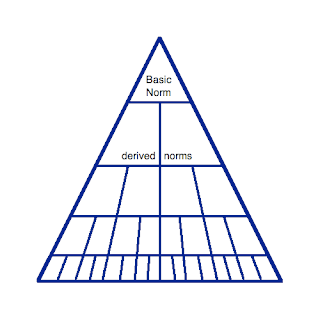In his column Politics and Society, "Rethinking Political Ideologies", Salvatore Chiarelli asserts that since quantitative models are fundamentally flawed when used for qualitative measurements, the traditional representations of the political spectrum are inadequate for properly comparing and contrasting political ideologies, and hence the need for a qualitative model.
Chiarelli proposes that the new analytical model be based on the work of the jurist and legal philosopher Hans Kelsen, who created a concept known as the Grundnorm, or “grand norm.” Kelsen used this word to denote the basic norm, order, or rule that forms the underlying basis for a legal system. This is a theoretical concept based on a need to find a point of origin on which the system can be legitimized. Conceptually, it is a pyramid with the top-most part being the basic norm and all other norms derived from this in an ordered and logical structure going down to the base of the pyramid (see below). Any norm not within this structure is seen as an illegitimate norm to the structure.
This essentially implies exploring complex political ideologies, both individual and syncretic. Syncretic ideologies are hybrids of disparate political philosophies and has often been dismissed by political parties that are modeled either on the uni-axis left-right political spectrum or on the bi-axis social/economic model.
Kelson's pyramid, which has a basic norm and lesser norms branching outward, better serves the civil community and political discourse. Although Kelsen applied his theory to legal systems and the basic norm of such a system is hypothetical, one cannot only apply it to political ideologies, but can deductively determine the basic norm of each one. Unlike a legal system, a political ideology is much more ordered and intellectually consistent with itself.
Ultimately, politics should not be about left-wing vs right-wing; it should be about answering such questions as hat public policy best benefits the people, what the appropriate role of Government should be, and how to cope with the challenges humanity faces in the future.
I will use this model both to analyze existing ideologies and to determine a core principle (the basic norm) from which an ideology can be derived.
REFERENCES
1. Rethinking political ideologies, Chiarelli, Salvatore [2009]
Chiarelli proposes that the new analytical model be based on the work of the jurist and legal philosopher Hans Kelsen, who created a concept known as the Grundnorm, or “grand norm.” Kelsen used this word to denote the basic norm, order, or rule that forms the underlying basis for a legal system. This is a theoretical concept based on a need to find a point of origin on which the system can be legitimized. Conceptually, it is a pyramid with the top-most part being the basic norm and all other norms derived from this in an ordered and logical structure going down to the base of the pyramid (see below). Any norm not within this structure is seen as an illegitimate norm to the structure.
This essentially implies exploring complex political ideologies, both individual and syncretic. Syncretic ideologies are hybrids of disparate political philosophies and has often been dismissed by political parties that are modeled either on the uni-axis left-right political spectrum or on the bi-axis social/economic model.
Kelson's pyramid, which has a basic norm and lesser norms branching outward, better serves the civil community and political discourse. Although Kelsen applied his theory to legal systems and the basic norm of such a system is hypothetical, one cannot only apply it to political ideologies, but can deductively determine the basic norm of each one. Unlike a legal system, a political ideology is much more ordered and intellectually consistent with itself.
I will use this model both to analyze existing ideologies and to determine a core principle (the basic norm) from which an ideology can be derived.
REFERENCES
1. Rethinking political ideologies, Chiarelli, Salvatore [2009]



No comments:
Post a Comment